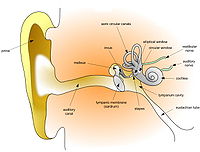
Photo from wikipedia
The objective was to evaluate the pure-tone audiogram-based screening protocols in VS diagnostics. We retrospectively analyzed presenting symptoms, pure tone audiometry and MRI finding from 246 VS patients and 442… Click to show full abstract
The objective was to evaluate the pure-tone audiogram-based screening protocols in VS diagnostics. We retrospectively analyzed presenting symptoms, pure tone audiometry and MRI finding from 246 VS patients and 442 controls were collected to test screening protocols (AAO-HNS, AMCLASS-A/B, Charing Cross, Cueva, DOH, Nashville, Oxford, Rule3000, Schlauch, Seattle, Sunderland) for sensitivity and specificity. Results were pooled with data from five other studies, and analysis of sensitivity, specificity and positive likelihood ratio (LR+) for each protocol was performed. Our results show that protocols with significantly higher sensitivity (AMCLASS-A/B, Nashville) show also significantly lowest specificity, and tend to have low association (positive likelihood ratio, LR+) to the VS. The highest LR+ was found for protocols AAO-HNS, Rule3000 and Seattle. In conclusions, knowing their properties, screening protocols are simple decision-making tools in VS diagnostic. To use the advantage of the highest sensitivity, protocols AMCLASS-A + B or Nashville can be of choice. For more reasonable approach, applying the protocols with high LR+ (AAO-HNS, Rule3000, Seattle) may reduce the overall number of MRI scans at expense of only few primarily undiagnosed VS.
Journal Title: Journal of Otology
Year Published: 2021
Link to full text (if available)
Share on Social Media: Sign Up to like & get
recommendations!